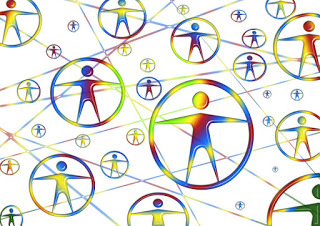Pearl Zhu's Blog, page 1317
July 17, 2016
Setting Principles to Run an Innovative IT
 Creativity is becoming increasingly crucial in today’s business environment because it it breeds innovation. But it’s common that many IT companies tend to focus more on their core competencies and often forget about the value of such innovation. Without innovation, organizations would be upstaged by the competitors that are creative because disruptive innovation will happen no matter you prepare well or not. IT needs to become a business’s innovation engine because the intersection of IT and people is where innovation happens. So how to set principles to encourage creativity and run an innovative IT in a systematic way?
Creativity is becoming increasingly crucial in today’s business environment because it it breeds innovation. But it’s common that many IT companies tend to focus more on their core competencies and often forget about the value of such innovation. Without innovation, organizations would be upstaged by the competitors that are creative because disruptive innovation will happen no matter you prepare well or not. IT needs to become a business’s innovation engine because the intersection of IT and people is where innovation happens. So how to set principles to encourage creativity and run an innovative IT in a systematic way?
Setting policies, tuning structure, and making programs as three levers to drive innovation: Innovation does need the certain level of guideline. Although by nature of creativity which is about breaking down the outdated rules and discover the new way to do things. However, “business creativity,” which is to apply the creative think” for problem solving and achieving business goals. To manage innovation in a structural way, you need to frame the creative process and leverage limited resources to keep focus, set time limits, apply varying thinking techniques in managing innovation portfolios in a more productive and sustainable way. Hence, the right level of guideline and the set of principles are important, not to stifle or tool “pushy,” but to streamline and standardize to manage innovation as a discipline, not just serendipity.
Being Customer Centric: Digital is the age of customer. When managing innovation life cycle, customer involvement at all stages often elicits highly valuable information. Listen to customers and involve them in the innovation process to gain insight and empathy. Customers perhaps not always know what they want for the next products or services, but they surely can provide insight into the goals, processes, and their contextual feedback is invaluable. Furthermore, Deep understanding of the user through empathetic observation with the innovator using a more inductive approach as to what the customer wants to accomplish “next.” Innovation is about transforming novel ideas and achieving its business value. It must prove its value in the market. Customer must be willing to pay for it, be it a product, process or service innovation. Hence, customers are one of the most important links in the innovation process.
 Setting principles and taking practices to measure IT innovation: It is true that the majority of IT organizations still cannot articulate their economic value to BoDs and shareholders in the common language the audience can understand, and IT performance metrics also is not sufficient in both measuring innovation and communicating IT effectiveness. Because the measurement should be oriented to justify innovations that the organization needs. One of the measurement practices is to define process KPIs, which demonstrate the growing capability of the organization to deliver more innovation with high business impact in the future. The consumerization of IT changes the way to run IT and business, there is still an IT element necessary to make all those pieces connect and run in a sustainable way. Select the few (3-5) KPIs, to keep the measure simple and easy to understand. The innovation metrics in the business context include such as, % of revenue from new products introduced, or measure something like % of the profit from new ideas implemented. The goals for measurement is to create new revenue and drive early success to create a positive spiral.
Setting principles and taking practices to measure IT innovation: It is true that the majority of IT organizations still cannot articulate their economic value to BoDs and shareholders in the common language the audience can understand, and IT performance metrics also is not sufficient in both measuring innovation and communicating IT effectiveness. Because the measurement should be oriented to justify innovations that the organization needs. One of the measurement practices is to define process KPIs, which demonstrate the growing capability of the organization to deliver more innovation with high business impact in the future. The consumerization of IT changes the way to run IT and business, there is still an IT element necessary to make all those pieces connect and run in a sustainable way. Select the few (3-5) KPIs, to keep the measure simple and easy to understand. The innovation metrics in the business context include such as, % of revenue from new products introduced, or measure something like % of the profit from new ideas implemented. The goals for measurement is to create new revenue and drive early success to create a positive spiral.
Keep in mind, setting principles and making policies to manage innovation is not about putting restrictions on what you can do, it is more about monitoring and knowing when things are not going on plan so that you can take appropriate actions at the right time. The leverage point is to structure innovation to keep focus, but not adding too much complexity. In short, the proper standard and processes will help set the right priority and manage innovation portfolio and lifecycle effectively. Follow us at: @Pearl_Zhu
Published on July 17, 2016 23:27
July 16, 2016
Three Identities to Harness Leadership Maturity
 Digitalization implies the full-scale changes in the way businesses are conducted and society is running. Digital is a disruption with rapidly increasing speed to break down silos and rigid hierarchy. It starts with leadership innovation. Because leadership is about CHANGE. It is a basic human ability to inspire self and others to look beyond limitations and set the right direction for advancement. Digital also raises the bar for leadership qualities. Here are three “leadership identities” to identify leadership authenticity and harness leadership maturity.
Digitalization implies the full-scale changes in the way businesses are conducted and society is running. Digital is a disruption with rapidly increasing speed to break down silos and rigid hierarchy. It starts with leadership innovation. Because leadership is about CHANGE. It is a basic human ability to inspire self and others to look beyond limitations and set the right direction for advancement. Digital also raises the bar for leadership qualities. Here are three “leadership identities” to identify leadership authenticity and harness leadership maturity.
Vision as your signature: As a citizen of any nation, the signature is one of the most important identities to deal with business partners in presenting your authenticity at the daily life. Metaphorically, vision is like the signature of your leadership, it’s what you stand for -A vision is how you see the future unfolding, how you dream about what the future will look like from your standpoint. The vision is every day that change is constant, there is always something to learn anytime, but one must be present at the place and at the right position to improve vision every day time. The clear leadership vision helps organizations to navigate through the uncharted water and across the blurred business territories. Vision is where to go, the strategy is how to get there. Vision is the visual interpretation of your finest dream of, or what you desire to become. Which inspires you and your followers and stakeholders. Vision must be translated into personal behavior from leaders to the rest of the team, but also in business structure, to provide for coherence to the organization in order to build up confidence for all stakeholders involved.
Capability as your drive license: The goal of leadership is also about steering toward the right direction, with the ability to reach the destination. Leadership is like driving but needs to have more complex capabilities and skillsets, such as problem-solving, creativity, communication, execution, etc. And like driving, effective leadership will fill the blind spots and know when to drive straight, and when to take the turn. Turn around the tough situations, and enjoy the challenges about complex problem-solving. It’s not about taking the shortcut, but selecting the optimal path to achieve the goals and fulfill the vision. Leadership has to lead self, as well as others, by developing the human capital in terms of capacity building and adapting to the dynamism of the turbulent socio-economic and political global trend, and by identifying the human values and helping talent to implement them and by developing their critical thinking skills in updating knowledge and solving complex problems.
 Multidimensional intelligence as your passport: Today’s leaders must present multidimensional intelligence, as both businesses and the world becomes over-complex and hyper-competitive. Intelligence is the capacity to understand and apply wisdom to the knowledge you are exposed to. Beside conventional IQ and EQ, you need to have the strategic intelligence to have long-term perspective, paradoxical intelligence to see the “both side of the coin,” cultural wisdom to gain empathy, and creative wisdom to think differently. Just like your passport, to allow you open your eyes via visiting a new place, leadership intelligence enables you to open mind and lead more effectively. Our intelligence with regard to any given type of information is a function of our capacity to recognize and interpret patterns, and also our consequent ability to use the perceived information to make effective decisions and sound judgment. With multidimensional intelligence, you can think through multi-dimensional angles to gain cognizance
Multidimensional intelligence as your passport: Today’s leaders must present multidimensional intelligence, as both businesses and the world becomes over-complex and hyper-competitive. Intelligence is the capacity to understand and apply wisdom to the knowledge you are exposed to. Beside conventional IQ and EQ, you need to have the strategic intelligence to have long-term perspective, paradoxical intelligence to see the “both side of the coin,” cultural wisdom to gain empathy, and creative wisdom to think differently. Just like your passport, to allow you open your eyes via visiting a new place, leadership intelligence enables you to open mind and lead more effectively. Our intelligence with regard to any given type of information is a function of our capacity to recognize and interpret patterns, and also our consequent ability to use the perceived information to make effective decisions and sound judgment. With multidimensional intelligence, you can think through multi-dimensional angles to gain cognizance
To deal with today’s digital dynamic and business complexity, leaders must have these crucial identities in order to lead effectively and effortlessly. At today’s digital dynamic, you have to envision for gaining a long-term perspective, you have to apply multi-dimensional intelligence (creative thinking, critical thinking, strategic thinking and system thinking) that goes into problem identification as well as solution discovering, and you have to build a set of differentiated capabilities, not just soft skills, to make leadership a “hard-core” discipline.
Follow us at: @Pearl_Zhu
Published on July 16, 2016 23:51
Three Hybrid Elements in Running a Digital IT and Organization
 With emergent digital technologies, organizations large or small reinvent themselves to become more agile, flexible and innovative. Digital doesn’t mean just tear down all the old things in the previous era, in reality, digital means to strike the right balance between the new way and the “old way,” the physical building and the virtual platform, the face-to-face communication and the always-on online presence. Here are three HYBRID elements in running a digital IT and organization. The hybrid decision-making style: Digital businesses are hyperconnected and over-complex, with overloading information and unprecedented uncertainty, and continually evolving in the digital dynamic ecosystem. Hence, it’s much more difficult to make effective decisions with the traditional top-down, one-way management style. Decision agility is dependent on better access to right information, at the right time - but also access to right people. Using the traditional ways of working in the silos and through the rigid processes simply won't have enough time to produce the input for the decision makers. More often than not, you need to allow a 'bottom up' approach to collect sufficient information and leverage collective wisdom. And then you can proceed to environmental, organizational and sociological factors that define the environment in which the decisions are made. Each of these opens the door to a variety of views.And without proper data or other input, no good decisions can be made. Business managers also have to live with the consequences of making the wrong decisions faster! Taking the hybrid styles to making leadership team's thinking visible by using a more democratic process for decision making will dramatically reduce or eliminate the gaps. Digital is the age of people. In complex operations and organizations, group dynamics leads to final results and performance, especially if the involvement of the activity is related to group inputs and processing!
With emergent digital technologies, organizations large or small reinvent themselves to become more agile, flexible and innovative. Digital doesn’t mean just tear down all the old things in the previous era, in reality, digital means to strike the right balance between the new way and the “old way,” the physical building and the virtual platform, the face-to-face communication and the always-on online presence. Here are three HYBRID elements in running a digital IT and organization. The hybrid decision-making style: Digital businesses are hyperconnected and over-complex, with overloading information and unprecedented uncertainty, and continually evolving in the digital dynamic ecosystem. Hence, it’s much more difficult to make effective decisions with the traditional top-down, one-way management style. Decision agility is dependent on better access to right information, at the right time - but also access to right people. Using the traditional ways of working in the silos and through the rigid processes simply won't have enough time to produce the input for the decision makers. More often than not, you need to allow a 'bottom up' approach to collect sufficient information and leverage collective wisdom. And then you can proceed to environmental, organizational and sociological factors that define the environment in which the decisions are made. Each of these opens the door to a variety of views.And without proper data or other input, no good decisions can be made. Business managers also have to live with the consequences of making the wrong decisions faster! Taking the hybrid styles to making leadership team's thinking visible by using a more democratic process for decision making will dramatically reduce or eliminate the gaps. Digital is the age of people. In complex operations and organizations, group dynamics leads to final results and performance, especially if the involvement of the activity is related to group inputs and processing!
The hybrid innovation management style: HYBRID is the digital fit style for managing innovation as well, because digital innovation portfolio includese both incremental or efficiency driven innovations, as well as radical and breakthrough innovations. Although all innovations are disruptive of something or some behavior to some degree. From portfolio management point of view, companies need both incremental product/service innovations to thrive, but also desire large, disruptive innovations for a quantum leap. Managing innovation requires leaders, either formal or informal, to shepherd an idea through several phases of development, knowing when to move forward and when to return to an earlier phase. It is hard to think of any innovation as not a hybrid, a combination of something old with something new or a number of new things. Innovations in the digital age are coming at seemingly a much faster pace, more change, more potential disruption, but the patterns and rules of communication are pretty much the same. You could consider all innovation by hybridized in that sense. Precisely that’s why it is an orthogonal concept to disruption.The broader the scope, scale and impact of the change, the more one leans towards calling such change an innovation.
 The hybrid organizational structure and management: Organizational structure underpins business processes, business processes underpin organizational capability, organizational capability underpin strategy execution. With emergent enterprise social platform and the variety of collaboration tools, The impact of digital/social technology is right on- that the future of the organization will become more ‘virtual.’ Businesses also need to fine tune their business structure and organizational system concentrated on cultural system, morale system, social system, material system, functional system and the holistic digital ecosystem, in achieving the next level of agility and maturity. A hybrid nature of organization well mixes the virtual social platform with the physical functional structure to enforce cross-functional collaboration and dot-connecting innovation. Hierarchical structures will be transcended to the interconnected, network structure. Look at all the elements, including the human element, as an integrated system and functions as an organic living thing. A hybrid organizational structure can bring greater awareness of the intricacies and the systemic value of organizational systems, processes, people dynamics, technology, resource allocation, supply side variables, market variables, economies of scale, etc.
The hybrid organizational structure and management: Organizational structure underpins business processes, business processes underpin organizational capability, organizational capability underpin strategy execution. With emergent enterprise social platform and the variety of collaboration tools, The impact of digital/social technology is right on- that the future of the organization will become more ‘virtual.’ Businesses also need to fine tune their business structure and organizational system concentrated on cultural system, morale system, social system, material system, functional system and the holistic digital ecosystem, in achieving the next level of agility and maturity. A hybrid nature of organization well mixes the virtual social platform with the physical functional structure to enforce cross-functional collaboration and dot-connecting innovation. Hierarchical structures will be transcended to the interconnected, network structure. Look at all the elements, including the human element, as an integrated system and functions as an organic living thing. A hybrid organizational structure can bring greater awareness of the intricacies and the systemic value of organizational systems, processes, people dynamics, technology, resource allocation, supply side variables, market variables, economies of scale, etc.
Building a hybrid digital organization starts with shaping a “hybrid mindset” at the top leadership level, to avoid any “extreme thinking,” silo management style, and inflexible discipline. It is about balance of stability and change; leadership decisiveness and collective wisdom, best practices (always do things this way) and next practices (discovering the better, digital way) and it’s a practical perspective to manage a digital transformation smoothly.
Follow us at: @Pearl_Zhu
Published on July 16, 2016 23:48
July 15, 2016
The Monthly CIO Debates Collection: What are the IT Innovation Dilemmas July 2016
Debating is not for stimulating conflicts, but for brainstorming better ways to do things.
 Due to the changing nature of technology, IT leadership role also continues to involve & shift the focus, to move up the maturity level. More and more CIOs are requested to take more responsibility and many CIOs present the breadth of leadership competency. The proactive IT debates help IT leaders to brainstorm innovative and better ways to do things, and improve management capabilities. Here are the monthly CIO debates collections on June, 2016.
Due to the changing nature of technology, IT leadership role also continues to involve & shift the focus, to move up the maturity level. More and more CIOs are requested to take more responsibility and many CIOs present the breadth of leadership competency. The proactive IT debates help IT leaders to brainstorm innovative and better ways to do things, and improve management capabilities. Here are the monthly CIO debates collections on June, 2016.
What are the IT Innovation Dilemmas July 2016Why Has IT Been Perceived as the ‘Weakest Link’ ? IT plays a more important role in the digital transformation of the organization. It is the superglue to connect both the hard elements of the business such as processes, platforms, technologies and soft elements of the organization such as information, knowledge, culture and integrate them into a set of business capabilities, which underpin the business strategy. However, there is the perception gap between IT looks at itself and the business perceives IT. IT is often seen itself as a business enabler and change agent, but business often thinks that IT is slower to change, and even be one of the “weakest links” for the business transformation. So why is IT not getting enough respect despite all good work and huge efforts were undertaken? Where does it link to improve IT brand? To deal with such a "He said, she said" dilemma: What are the different perspectives from each party, how to integrate them into a holistic IT view and reinvent the tarnished IT reputation.
What are IT Management Dilemma?Technology is pervasive, business initiatives, changes, and transformation today nearly always involve some form of technology implementation or information analysis; IT touches both hard business processes and soft human behaviors. However, managing a highly effective IT is not an easy job, IT leaders have to overcome many change management roadblocks and deal with quite a few of IT management dilemmas in transforming from a cost center to value creator, from a support function to a strategic business partner; from a back office to an innovation front yard.
Who can Make Better, Faster IT Decision? From industry survey, 79% of C-level business executives believe they can make technology decisions better and faster than IT staff. What is your response to this? How can CIOs and IT organizations change this perception?
Can Money Buy Innovation? It is very important to recognize that innovation is an essential factor for a company success. Organizations need both: out of the box and in the box/core innovation; both breakthrough innovation and incremental and evolutionary innovation, how to accomplish this balance is a crucial issue for organizations. From innovation management perspective, what’re the resources and key success factors to lead innovation success, can money buy innovation?
 IT Dilemma: Is Customer Always RIGHT? IT has always gone through this dilemma of "customers is always right" vs. "rational approach in designing a solution." If IT always see this as two conflicting forces pulling in opposite directions, you are most likely to get caught and always fall short of expectations. So what’s the right attitude in the face of such customer dilemma?
IT Dilemma: Is Customer Always RIGHT? IT has always gone through this dilemma of "customers is always right" vs. "rational approach in designing a solution." If IT always see this as two conflicting forces pulling in opposite directions, you are most likely to get caught and always fall short of expectations. So what’s the right attitude in the face of such customer dilemma?
The “Future of CIO” Blog has reached 1.3 million page views with 2900+ blog posting in 59+ different categories of leadership, management, strategy, digitalization, change/talent, etc. blog posting. The content richness is not for its own sake, but to convey the vision and share the wisdom. Blogging is not about writing, but about thinking and innovating the new ideas; it’s not just about WHAT to say, but about WHY to say, and HOW to say it. It reflects the color and shade of your thought patterns, and it indicates the peaks and curves of your thinking waves. Unlike pure entertainment, quality and professional content takes time for digesting, contemplation and engaging, and therefore, it takes time to attract the "hungry minds" and the "deep souls." It’s the journey to amplify diverse voices and deepen digital footprints, and it's the way to harness your innovative spirit.
Follow us at: @Pearl_Zhu
 Due to the changing nature of technology, IT leadership role also continues to involve & shift the focus, to move up the maturity level. More and more CIOs are requested to take more responsibility and many CIOs present the breadth of leadership competency. The proactive IT debates help IT leaders to brainstorm innovative and better ways to do things, and improve management capabilities. Here are the monthly CIO debates collections on June, 2016.
Due to the changing nature of technology, IT leadership role also continues to involve & shift the focus, to move up the maturity level. More and more CIOs are requested to take more responsibility and many CIOs present the breadth of leadership competency. The proactive IT debates help IT leaders to brainstorm innovative and better ways to do things, and improve management capabilities. Here are the monthly CIO debates collections on June, 2016.
What are the IT Innovation Dilemmas July 2016Why Has IT Been Perceived as the ‘Weakest Link’ ? IT plays a more important role in the digital transformation of the organization. It is the superglue to connect both the hard elements of the business such as processes, platforms, technologies and soft elements of the organization such as information, knowledge, culture and integrate them into a set of business capabilities, which underpin the business strategy. However, there is the perception gap between IT looks at itself and the business perceives IT. IT is often seen itself as a business enabler and change agent, but business often thinks that IT is slower to change, and even be one of the “weakest links” for the business transformation. So why is IT not getting enough respect despite all good work and huge efforts were undertaken? Where does it link to improve IT brand? To deal with such a "He said, she said" dilemma: What are the different perspectives from each party, how to integrate them into a holistic IT view and reinvent the tarnished IT reputation.
What are IT Management Dilemma?Technology is pervasive, business initiatives, changes, and transformation today nearly always involve some form of technology implementation or information analysis; IT touches both hard business processes and soft human behaviors. However, managing a highly effective IT is not an easy job, IT leaders have to overcome many change management roadblocks and deal with quite a few of IT management dilemmas in transforming from a cost center to value creator, from a support function to a strategic business partner; from a back office to an innovation front yard.
Who can Make Better, Faster IT Decision? From industry survey, 79% of C-level business executives believe they can make technology decisions better and faster than IT staff. What is your response to this? How can CIOs and IT organizations change this perception?
Can Money Buy Innovation? It is very important to recognize that innovation is an essential factor for a company success. Organizations need both: out of the box and in the box/core innovation; both breakthrough innovation and incremental and evolutionary innovation, how to accomplish this balance is a crucial issue for organizations. From innovation management perspective, what’re the resources and key success factors to lead innovation success, can money buy innovation?
 IT Dilemma: Is Customer Always RIGHT? IT has always gone through this dilemma of "customers is always right" vs. "rational approach in designing a solution." If IT always see this as two conflicting forces pulling in opposite directions, you are most likely to get caught and always fall short of expectations. So what’s the right attitude in the face of such customer dilemma?
IT Dilemma: Is Customer Always RIGHT? IT has always gone through this dilemma of "customers is always right" vs. "rational approach in designing a solution." If IT always see this as two conflicting forces pulling in opposite directions, you are most likely to get caught and always fall short of expectations. So what’s the right attitude in the face of such customer dilemma?The “Future of CIO” Blog has reached 1.3 million page views with 2900+ blog posting in 59+ different categories of leadership, management, strategy, digitalization, change/talent, etc. blog posting. The content richness is not for its own sake, but to convey the vision and share the wisdom. Blogging is not about writing, but about thinking and innovating the new ideas; it’s not just about WHAT to say, but about WHY to say, and HOW to say it. It reflects the color and shade of your thought patterns, and it indicates the peaks and curves of your thinking waves. Unlike pure entertainment, quality and professional content takes time for digesting, contemplation and engaging, and therefore, it takes time to attract the "hungry minds" and the "deep souls." It’s the journey to amplify diverse voices and deepen digital footprints, and it's the way to harness your innovative spirit.
Follow us at: @Pearl_Zhu
Published on July 15, 2016 23:32
Three “DE” Effort in Digitizing the Organization
 Digital makes a significant impact on every aspect of the business from people, process to technology, both horizontally and vertically. Businesses become hyperconnected and interdependent, and gets involving in the digital ecosystem all the time. Given the power of the cloud, social, mobile and analytics digital technologies to fuel business innovation, capability orchestration, and employee collaboration, digital becomes the very fabric of high performing business. Here are three “DE” effort to shift from “doing Digital” -using digital technologies to “Being Digital” - Running a high mature digital organization.
Digital makes a significant impact on every aspect of the business from people, process to technology, both horizontally and vertically. Businesses become hyperconnected and interdependent, and gets involving in the digital ecosystem all the time. Given the power of the cloud, social, mobile and analytics digital technologies to fuel business innovation, capability orchestration, and employee collaboration, digital becomes the very fabric of high performing business. Here are three “DE” effort to shift from “doing Digital” -using digital technologies to “Being Digital” - Running a high mature digital organization.
Debug the organizational mindset: Organizational mindset is the collective mindset of its people - culture, it’s about how people think and do things here, the collective attitude and behavior. To go digital in a structural way and develop a systematic innovation - you need to have the organizational culture correct underneath - many companies can put in place a good systematic approach in process terms, but if the underlying culture doesn’t support risk taking, collaboration, learning (often via "failure") and self-empowerment, then it’s very difficult to get the best out of the process. The shift to digital cuts across sectors, geographies and leadership roles. But dealing with the challenge of digital change requires an accelerated digital mindset, taking an end-to-end response, building a comprehensive digital strategy, and rethinking the business and operating models, etc. The mind-set is far more important than talent. Talent can always be developed by those with an open and right mind-set. Hence, Leaders and talent with digital transformational mind are in higher demand, as transformational leadership is all about change.As the vision and mission of the organization all come under artifacts and go a long way in deciding the culture of the workplace. Metaphorically, organizational culture is like the computer app, once a while, you have to debug and update the version, and keep it running smoothly.
Delaying organizational structure: The digital transformation is now spreading rapidly to enable organizations of all shapes and sizes to reinvent themselves, retune organizational structure, optimize business processes and capabilities. If structure drives behavior and people are able of (self-)reflection, then the responsibility could be to reflect on the organizational structure and the behavior, give feedback and - if necessary, aim for and facilitate changing of the structure. Delayering becomes a lens through which it is possible to examine and then fix many other issues. If you're an employee, you can ask your manager to change the structure. If you're a manager, you can change the structure by changing the way of working, tasks, roles, and responsibilities,etc.The mechanistic production metaphor is replaced with organic growth metaphor, operational centrism becomes multi-disciplinary people-centrism, the linear system perception is replaced by complex nonlinear and adaptive system discipline, a goal-seeking system becomes purposeful, and technical behavior is replaced by socio-technical behavior. If you have a rigid organization that realizes it’s not viable or relevant, there’s a necessity switching to a fluid state, a fluid organization is adaptive to change, creative and flexible.
 Debunk the myth of enterprise digital maturity: Digital makes profound impact from specific functions to the business as a whole. The purpose of such radical digitalization is to make a significant difference in the overall levels of customer delight and achieve high performing business results. High mature digital organizations have highly innovative culture and create workforce, hence, they can not only build high level digital capabilities, but also drive enterprise-wide transformation. And they reap long term benefit from the efforts.
Debunk the myth of enterprise digital maturity: Digital makes profound impact from specific functions to the business as a whole. The purpose of such radical digitalization is to make a significant difference in the overall levels of customer delight and achieve high performing business results. High mature digital organizations have highly innovative culture and create workforce, hence, they can not only build high level digital capabilities, but also drive enterprise-wide transformation. And they reap long term benefit from the efforts.
Digital makes profound impact from specific function to business as a whole, the truth is that both the digital world and the physical one are indispensable parts of the business. Radical digital takes these “DE” effort, not through linear steps, but via cross-functional communication, iterative collaboration and ongoing change management capability. The real digital transformation taking place today isn’t the replacement of the one by the other; but harmonizing the hybrid nature of digitalization and making the well combinations that create wholly new sources of value and achieve high level digital maturity.
Follow us at: @Pearl_Zhu
Published on July 15, 2016 23:27
July 14, 2016
The Weekly Insight of the “Future of CIO” 7/15/2016
 The “Future of CIO” Blog has reached 1.3 million page views with 2900+ blog posting in 59+ different categories of leadership, management, strategy, digitalization, change/talent, etc. The content richness is not for its own sake, but to convey the vision and share the wisdom. Here is the weekly insight about digital leadership, IT Management and Talent Management.
The “Future of CIO” Blog has reached 1.3 million page views with 2900+ blog posting in 59+ different categories of leadership, management, strategy, digitalization, change/talent, etc. The content richness is not for its own sake, but to convey the vision and share the wisdom. Here is the weekly insight about digital leadership, IT Management and Talent Management.
The Weekly Insight of the “Future of CIO” 7/15/2016"CIO Master" Book Tuning XXXXXXIII: Three Digital Balances IT Needs to Strike: IT is a system which has an emergent property of individual human beings making sense of experiences in time and place, IT system makes interactions with the environment to collecting, storing, processing and delivering information, and ensure the right people getting the right information at the right time to make the right decision. IT organization plays a significant role in both keeping the business bottom line and contributing to the top line business growth; setting the standard for risk management, as well as leveraging the latest tools and platforms to enable innovation; IT is also crucial to fix the handy, urgent business problems, as well as digitizing the touch points of customer experience for the business’s long-term transformation. In practices, there are three digital balances IT needs to strike in order to improve its efficiency, effectiveness, agility, and maturity.
Building a Set of “Digital-Ready” Cultures Organizations large or small are on the journey of digital transformation, strategy making is important, strategy implementation is challenging, and one of the most critical business success factors is organizational culture, which is invisible, but powerful to fail a good strategy. Culture is a collective mindset, attitude, and it is shaped based on policies, procedures, rewards and retributions that drive behavior and it is the employee behavior that expresses "culture." In order to drive a successful digital transformation, how to build a “Digital-Ready” culture, though?
Running Digital IT from “Outside-In”: Traditional IT organizations are inside-out operation-driven, and the company relies on an IT system via standardized usage of technologies, but often treated as the commodity. Nowadays, at the dawn of the Digital Era, information is one of the most invaluable business assets and technologies are disruptive forces behind the digital transformation. How to run a digital IT from “Outside-In,” as a customer advocate and a business differentiator?
Sharpen Three Business Elements to Get the Organization “Digital Ready” Organizations large and small are on the journey of digital transformation. “Being digital ready” goes beyond just applying the latest digital technology, or renovate IT organization only. It is a holistic effort and multifaceted discipline to touch every aspect of the business. Here are three critical business elements need to be sharpened in order to get the organization “Digital Ready”?
 The Monthly Digital Leadership Brief July, 2016: From one generation to the next, the substance of leadership does not change, it’s about future, change, and influence, it's about setting the direction for self and others to follow. However, the digital leadership trends will continue to emerge. Here is a set of featured blogs posted in this month to brainstorm the future of digital leadership.
The Monthly Digital Leadership Brief July, 2016: From one generation to the next, the substance of leadership does not change, it’s about future, change, and influence, it's about setting the direction for self and others to follow. However, the digital leadership trends will continue to emerge. Here is a set of featured blogs posted in this month to brainstorm the future of digital leadership.Blogging is not about writing, but about thinking and innovating the new ideas; it’s not just about WHAT to say, but about WHY to say, and HOW to say it. It reflects the color and shade of your thought patterns, and it indicates the peaks and curves of your thinking waves. Unlike pure entertainment, quality and professional content takes time for digesting, contemplation and engaging, and therefore, it takes the time to attract the "hungry minds" and the "deep souls." It’s the journey to amplify diverse voices and deepen digital footprints, and it's the way to harness your innovative spirit.
Follow us at: @Pearl_Zhu
Published on July 14, 2016 23:35
Three “Interwined” Words to Boost Creativity
 Creativity is about connecting the dots. Creativity is a specific way one or some human brains process information that results in unusual combinations of ideas, insights, metaphors, applications, procedures, and sometimes 'things.' Creativity is a multidimensional thought process, higher level thinking capability and often multidisciplinary association. Here are three INtertwined words to spark creativity -the innate ability to create novel ideas, and drive innovations -transform ideas to achieve its business value.
Creativity is about connecting the dots. Creativity is a specific way one or some human brains process information that results in unusual combinations of ideas, insights, metaphors, applications, procedures, and sometimes 'things.' Creativity is a multidimensional thought process, higher level thinking capability and often multidisciplinary association. Here are three INtertwined words to spark creativity -the innate ability to create novel ideas, and drive innovations -transform ideas to achieve its business value.
Ingenuity: Ingenuity is the ability to solve difficult problems, often in the original and creative way. Ingenuity is often connotated with insight or perception. Some say ingenuity is the distant cousin of creativity, ingenuity often demands creativity as a mixed ingredient for puzzle-solving or invention. Being ingenious needs more understanding, not less. It is the qualification to be creative, insightful and inventive. Human ingenuity often involve some most complex thought processes such as creative thinking, Systems thinking, analytical thinking, etc, both individually and collectively. It is one of an important human capabilities to bring evolutionary, changes and even revolutionary breakthrough. Intuition: Intuition is one element for our unconscious process which is created out of our distilled experiences. An intuitive mind has the strength and the willpower to follow the courageous heart, and thus, having the better chance to be creative. Intuition is often called as “gut feeling,” sometimes, not just the emotional side of the mind, or a “fast thinking” scenario, it’s an inner calling, you have to have both sense and sensitivity, listen to it, learn how to liberate self and come up with a new approach to the problem. Intuition is a deeper sense, should be taken as a new insight, a new idea, and a new angle. Then you are courageous enough to follow the gut and curious enough to understand the surroundings. However, pay more attention to the unconscious bias, “thinking fast,” and “thinking slow,” need to be taken wisely, in order to leverage intuition for spurring innovation, but avoid pitfalls and blind spots.
 Imagination: Imagination is the seed to grow innovation. Knowledge is limited, but imagination is limitless. Knowledge is narrow, but imagination is wild. A great wealth of knowledge fuels imaginations. However, being creative is not just being knowledgeable, because creativity is often transdisciplinary, and interconnected with many seemly unrelated dots, it’s the ability to expand the boundaries of knowledge, and capture insight. That creativity in the human sense is not due to connecting of two shallow pools of knowledge, but the ability to dig deep and to make deep connections and build on those connections. Imagination inspires your learning attitude as well. often imagination blooms at the beginner’s mind; they enjoy experimenting and discovering; there’s no rule to limit their imagination. An open mind leads to imagination, and Imagination leads to discovery, and discovery leads to innovation, and innovation leads to technology advancement and societal progression.
Imagination: Imagination is the seed to grow innovation. Knowledge is limited, but imagination is limitless. Knowledge is narrow, but imagination is wild. A great wealth of knowledge fuels imaginations. However, being creative is not just being knowledgeable, because creativity is often transdisciplinary, and interconnected with many seemly unrelated dots, it’s the ability to expand the boundaries of knowledge, and capture insight. That creativity in the human sense is not due to connecting of two shallow pools of knowledge, but the ability to dig deep and to make deep connections and build on those connections. Imagination inspires your learning attitude as well. often imagination blooms at the beginner’s mind; they enjoy experimenting and discovering; there’s no rule to limit their imagination. An open mind leads to imagination, and Imagination leads to discovery, and discovery leads to innovation, and innovation leads to technology advancement and societal progression.
Creativity has many “INgredents.” It is the flow and a full color spectrum. It doesn’t live inside abox, but a type of out-of-box thinking. So you have to pull it out of the box and look at it through different lenses. The root of our differences is in the different perceptions and the lenses we use, which we have with respect to creativity or innovations. An essential aspect of creativity, both at individual or group level, is the ability to challenge assumptions, conclusions, and beliefs, to discover the better way, experiment the new things, or simply just think differently.
Follow us at: @Pearl_Zhu
Published on July 14, 2016 23:32
Three Insight of Dynamic Digital Capability
 Corporate capability is the collective ability to implement strategy, innovation and make changes. It is underpinned by business processes, integrated by IT and enabled by talented employees. Business capability is an acquired and organized "ability" within a company and takes hard work to put in place; it can therefore not be transferred because of the degree of organizational learning. At the dawn of the digital era with hyperconnectivity and fierce competition, organizations have to build a set of differentiated capabilities which will directly decide the overall organization’s competency. What are the characteristics of digital capabilities? What things are in place that will inhibit or endanger the capability building? Are the right skills in place? Are costs in line with the long-term path and short term goals?
Corporate capability is the collective ability to implement strategy, innovation and make changes. It is underpinned by business processes, integrated by IT and enabled by talented employees. Business capability is an acquired and organized "ability" within a company and takes hard work to put in place; it can therefore not be transferred because of the degree of organizational learning. At the dawn of the digital era with hyperconnectivity and fierce competition, organizations have to build a set of differentiated capabilities which will directly decide the overall organization’s competency. What are the characteristics of digital capabilities? What things are in place that will inhibit or endanger the capability building? Are the right skills in place? Are costs in line with the long-term path and short term goals?
Digital capability coherence: Digital strategy execution is a dynamic continuum. How effective the strategy execution is directly dependent on how coherence of its business capabilities.The organization’s competency is based on the set of differentiated and cohesive capabilities and how fast and effective to build on. Organization’s capabilities can be categorized into the competitive necessity and competitive uniqueness.The company need to take the following steps to truly understand its capabilities and build blocks, and continually refine them for improving its agility and maturity. (a) first, identify its core capabilities, and hone them into organization-wide competency. (b) Compare itself with competitors to ensure that it is developing differentiated capabilities to gain unique competency. © Have in-depth understanding of what capabilities are important to achieve customer-centricity (customers truly value them), etc. (d) Create an organizational strategy-capability mapping and make a roadmap that sets goals for competence building. (e) Encourage communication and involvement in core capability development across the organization. (f) Divest non-core capabilities to free up resources that can be used to deepen core capabilities.
Digital Capability Integration: Digital capability is dynamic due to the increasing speed of change. The dynamic capabilities' are defined as the firm's ability to integrate, build, and reconfigure internal and external competences to address rapidly changing environments. The core business capabilities are often built via cross-functional process management and talent management, and applying IT as “superglue.” There are some of the issues where must be aware of integration of a single functional capability into a holistic portfolio of digital capabilities across all enterprises, arising from cross-silo or cross-divisional collaboration is crucial to making seamless integration and building dynamic digital capabilities.
 Digital capability maturity: Every organization has some capabilities, the capability maturity will decide which companies are digital leaders, and which one are digital laggards. which attributes should be measured? Since a capability is made up of people, processes, and technology, you can use overall process maturity as one part. To improving digital maturity, the processes have to be fine tuned to adapt to change and capabilities need to be optimized to achieve efficiency. However, digital capability is not just about “doing more with less,” but about “doing more with innovation,” with continuous renewal for digital transformation. With a maturity attribute like "adoption,", “agility,” “flexibility,””measurability,” you can measure the percentage of business units engaging the capability on a year by year basis. As it increases, the maturity rises. One way to measure "value" is by assessing the capability's effectiveness in achieving the desired outcome. This can be accomplished by measuring (a) the technology impact on capability effectiveness. and (b) the process impact on capability effectiveness (# of orders delivered, order cycle time), etc. In other words, capability maturity can be measured against achievement of desired business or customer outcomes. The maturity of a business capability would be based on the ability to deliver on customer needs or to achieve the desired capability outcome. Other criteria may include the importance of each capability to the enterprise; different weighting may be applied to the capabilities.
Digital capability maturity: Every organization has some capabilities, the capability maturity will decide which companies are digital leaders, and which one are digital laggards. which attributes should be measured? Since a capability is made up of people, processes, and technology, you can use overall process maturity as one part. To improving digital maturity, the processes have to be fine tuned to adapt to change and capabilities need to be optimized to achieve efficiency. However, digital capability is not just about “doing more with less,” but about “doing more with innovation,” with continuous renewal for digital transformation. With a maturity attribute like "adoption,", “agility,” “flexibility,””measurability,” you can measure the percentage of business units engaging the capability on a year by year basis. As it increases, the maturity rises. One way to measure "value" is by assessing the capability's effectiveness in achieving the desired outcome. This can be accomplished by measuring (a) the technology impact on capability effectiveness. and (b) the process impact on capability effectiveness (# of orders delivered, order cycle time), etc. In other words, capability maturity can be measured against achievement of desired business or customer outcomes. The maturity of a business capability would be based on the ability to deliver on customer needs or to achieve the desired capability outcome. Other criteria may include the importance of each capability to the enterprise; different weighting may be applied to the capabilities.
The business capability coherence is the decisive factor for the success of strategy implementation. The right set of unique Dynamic Capabilities directly decide the overall organization’s competency, and how well they can make digital transformation, deliver the value to the customers and build long term winning position.
Follow us at: @Pearl_Zhu
Published on July 14, 2016 23:28
July 13, 2016
The Spotlight on Digital CIOs July 2016
 Modern CIOs have many personas and face great challenges.
Modern CIOs have many personas and face great challenges.
Modern CIOs have many personas and face great challenges. It is not sufficient to only keep the light on. Regardless of which industry or the nature of organization you are in, being a digital leader will need to master the art of creating unique, differentiating value from piles of commoditized technologies, but more specifically, what are the digital-savvy CIOs doing to run IT as a value creator and innovation engine? Here is the monthly spotlight of the CIO.
The Spotlight of Digital CIOs July 2016Three Traits in IT High-Professionalism Due to the fast pace of technology update and information flow, IT skills gap is the reality, not fiction; due to the complex nature of technology, and intense workload of IT, IT leaders and professionals have to continue updating knowledge, staying focused on solving complex problems, and always challenge the new way to do things. Compared to many other professionals, the high-quality IT professionals have to learn more intensively, do things more creatively, think and make decisions more intellectually. What are important traits in IT high-professionalism?
“CIO Master” Book Review: Chapter 4 CIO as Talent Master Introduction: People are always the most invaluable asset in any business. “Hiring the right person with the right capability for the right position at the right time,” is the mantra for any forward-looking organization at the Digital Era. The point is how would you define the right people, how do you define wrong, average, mediocre, good, great or extraordinary person? Is IT skills gap fact or fiction? Shall you hire character, mindset, or skills? What’s the best way to build a solid digital pipeline for discovering authentic and high potential leaders and digital professionals for the business growth?
“CIO Master” Book Review: Chapter 3 “CIOs as Change Agent” Introduction: Change is inevitable. And the speed of change is accelerating. Often information abundance catalyzes change, and technology is the disruptive force behind changes. Hence, CIOs shouldn’t get pushed for the changes, they are actually in a better position to play a role as change agent. Many forward-looking organizations empower their CIOs as forerunners to drive changes and lead digital transformation at the organizational level. CIOs as Change Agents: How to lead change effectively?
“CIO Master” Book Review: Chapter 2 “CIOs as Digital Visionary” Introduction”: The Digital Era makes a significant impact on every aspect of the business from people to process, to technology, both horizontally and vertically. In many forward-looking organizations, IT plays a pivotal role in such a radical transformation. The CIO also becomes a strategic leadership role in conveying the digital vision and co-create business strategy and reinventing IT as a growth and innovation engine of the organization. More specifically, visionary CIOs play the following unique role.
 “CIO Master” Book Review: Chapter 1 “Twelve Digital CIO Personas” Introduction: Nowadays, information is lifeblood, and technology is the disruptive force in any business and any industry. Hence, CIOs as IT leaders play a more critical role in business strategy making & execution, digital transformation, driving business changes and innovation. Compared to other CxO positions, the CIO role is considerably new with less than three decades of history, but more dynamic and paradoxical. The IT leadership role also continues to be reimagined, refined, refreshed, and reenergized. The CIO is no longer just a glorified geek, but a business savvy strategist and transformational business leader. Modern CIOs have multiple personas and need to wear many hats to communicate effectively and lead more successfully. In chapter 1 of “CIO Master - Unleash the Digital Potential of IT,” we describe CIOs’ 12 Digital profiles. Here we list five featured CIO personas:
“CIO Master” Book Review: Chapter 1 “Twelve Digital CIO Personas” Introduction: Nowadays, information is lifeblood, and technology is the disruptive force in any business and any industry. Hence, CIOs as IT leaders play a more critical role in business strategy making & execution, digital transformation, driving business changes and innovation. Compared to other CxO positions, the CIO role is considerably new with less than three decades of history, but more dynamic and paradoxical. The IT leadership role also continues to be reimagined, refined, refreshed, and reenergized. The CIO is no longer just a glorified geek, but a business savvy strategist and transformational business leader. Modern CIOs have multiple personas and need to wear many hats to communicate effectively and lead more successfully. In chapter 1 of “CIO Master - Unleash the Digital Potential of IT,” we describe CIOs’ 12 Digital profiles. Here we list five featured CIO personas: The “Future of CIO” Blog has reached 1.3 million page views with about #2800th blog posting in 59+ different categories of leadership, management, strategy, digitalization, change/talent, etc. The content richness is not for its own sake, but to convey the vision and share the wisdom. Blogging is not about writing, but about thinking and innovating the new ideas; it’s not just about WHAT to say, but about WHY to say, and HOW to say it. It reflects the color and shade of your thought patterns, and it indicates the peaks and curves of your thinking waves. Unlike pure entertainment, quality and professional content takes time for digesting, contemplation and engaging, and therefore, it takes the time to attract the "hungry minds" and the "deep souls." It’s the journey to amplify diverse voices and deepen digital footprints, and it's the way to harness your innovative spirit.
Follow us at: @Pearl_Zhu
Published on July 13, 2016 23:31
Three Aspects in Digitizing the Boardroom
 Due to the increasing velocity and variety of changes in the digital era, corporate board, as one of the most significant governance bodies, also faces the unprecedented changes, including the new perspective of boardroom composition, the unprecedented board dynamic, and emergent best/next practices. In short, digitizing the boardroom is inevitable, because as the top leadership team, the board just needs to exemplify and walk the talk in driving the business transformation.
Due to the increasing velocity and variety of changes in the digital era, corporate board, as one of the most significant governance bodies, also faces the unprecedented changes, including the new perspective of boardroom composition, the unprecedented board dynamic, and emergent best/next practices. In short, digitizing the boardroom is inevitable, because as the top leadership team, the board just needs to exemplify and walk the talk in driving the business transformation.
The digital board composition: The best fit for the board depends on the Board’s current makeup and culture and which "gap" needs to be filled. Business management and governance are interdependent disciplines to keep businesses move towards the right direction with the proper speed. The board provides an “outside-in” view of the business and multi-dimensional lenses to oversee and advise business strategy and execution and steer business toward the right direction. A “digital fit” board with fresh eyes is anyone willing to challenge the current level of 'group' think. The Board is responsible for ensuring an appropriate mix of skills, knowledge and experience are present or available for it to fulfill its function. So the board composition needs to embrace both cognitive difference, functional difference, and other skill difference. Whereas what interested in BoD is mindfulness. Appreciates that the value of alternative perspectives and insights which say nothing of not trusting - simply looking from a different stance, and asking different questions. The important issue is how the board accommodates diverse opinions and how they assess them and converge the diverse thought into wise decisions all BoDs' support.
The Board dynamic: It means keeping the organization intact by ensuring sustainability. Every board decision is particular to the objectives, circumstances and board dynamics. The high-effective board can make effective decisions in deliberation, moving the enterprise forward, ensuring the organization makes sense, etc. These are strategies associated with the execution of the governance. There is good and bad judgment. It is to define the best possible working equilibrium between the often conflicting forces and drivers, both external and internal, whether imposed or adopted, acting on the organization’s vision and strategy. Maintaining the great board dynamic can help transform the emotional board to an effective board via self-check: Does it make sense? Can the person identify if there are insufficient "facts" to allow a conclusion to be formed? Are BoDs willing to change their mind when faced with new and relevant facts? Does the BoD have a track record of getting it right most of the time? If the company's mission, stakeholders, and strategy have been clearly established - then this emotional appeal can be tested against those and the stated values of the organization.
 The Board Digital/Global Practices: The digital board has global touch and in-depth understanding about the digital dynamic and develop a set of best and next practice to improve its effectiveness. Global boards will, for the most part, go through a learning process, relationship building and understanding of what it takes to get cross-cultural agreements. Accountability should be a common thread throughout all global boards, regardless of nation diversity. Making a set of common principles to communicate and collaborate across geographical borders, industrial borders, and functional borders. It starts with agenda agreements before moving forward but takes patience and understanding of potential obstacles, differences, and language that translates common meaning.
The Board Digital/Global Practices: The digital board has global touch and in-depth understanding about the digital dynamic and develop a set of best and next practice to improve its effectiveness. Global boards will, for the most part, go through a learning process, relationship building and understanding of what it takes to get cross-cultural agreements. Accountability should be a common thread throughout all global boards, regardless of nation diversity. Making a set of common principles to communicate and collaborate across geographical borders, industrial borders, and functional borders. It starts with agenda agreements before moving forward but takes patience and understanding of potential obstacles, differences, and language that translates common meaning.
Digitizing boardroom is not an overnight rush, but a well-planning journey. A wise and effective Board exhibits a creative tension, that hard to define, but you know it when you see it. There is still a long way to achieving corporate governance maturity. But it’s worth the effort, and indeed, it’s one of most crucial step in the radical digital transformation of businesses, industries, and the society.
Follow us at: @Pearl_Zhu
Published on July 13, 2016 23:28



